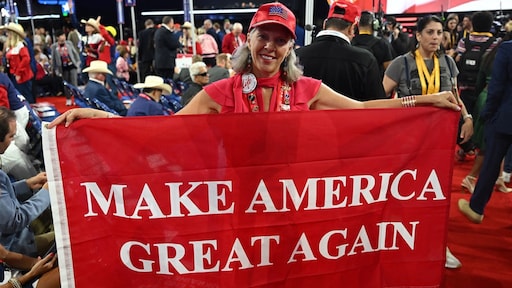By Chris Konis··Edited:

RTL
If he returns to the US presidency in November, Donald Trump is promising his voters an end to hyperinflation and ensuring a much stronger economy. But how he intends to achieve this is still unclear.
Now that Donald Trump has shaken off all his Republican opponents, he may face Democrat Joe Biden in November’s presidential election. The incumbent president has come under intense pressure for his chaotic performances, but he has refused to drop out of the race for now.
Biden’s presidency has been characterized by high inflation and exceptionally large investments at home. He signed stimulus packages worth hundreds of billions of dollars for infrastructure, tax relief during the coronavirus crisis, climate, jobs and a national chip industry.
With this broad public investment agenda, Biden continues the course set by his predecessor, Trump. That is, global free trade no longer allows its course, but prefers to produce more domestically and enforce this by making foreign products more expensive with the help of higher import duties. In short: through old-fashioned protectionism.
Very high national debt
Whoever wins the upcoming US presidential election will face a rapidly changing US economy. Because of all the support packages, the country has historically struggled with high national debt. It’s now nearly $35 trillion: more than 120 percent of the total size of the U.S. economy.
International Monetary Fund (IMF) refers to The ever-increasing national debt is ‘worrisome’ because it poses risks to ‘both domestic and global economies’. The country continues to struggle with inflation and structural labor shortages.
‘Biggest Tax Cut’
If Trump is re-elected, he promises to make sure “all prices come down quickly.” “Inflation is killing our country. It doesn’t matter what you earn because inflation is eating you alive.” Trump said During his speech at the Republican convention in Milwaukee last night.
Inflation in the US rose to 9.1 percent in 2022 in the wake of the coronavirus crisis, but has since fallen back to 3 percent last month. That’s more than a percentage point above the U.S. central bank’s 2 percent inflation target.
The question is how Trump intends to achieve it. He has not yet put forward any concrete economic policy plans or laws. He promises to “beat” inflation, as well as the “biggest tax cut in history.”
US news outlet AP sent Trump’s campaign team twenty “fundamental” questions last month to clarify his economic views. They got it There is no answer. Instead, the group sent some links to video clips of Trump.
Last night, Trump didn’t get much more than a series of one-liners and promises. For example, he said he would “save the U.S. auto industry from total destruction,” incomes would “soar” and the “middle class would flourish like never before.”
That stands in stark contrast to Biden’s 188-page budget proposal, in which he called for tax breaks for families and homebuyers, lower health care costs and lower national debt by raising taxes on the wealthiest Americans and corporations.
“It’s not really that easy to get a complete overview of Trump’s policy plans,” says Rogier Quaedvlieg, an analyst of the US economy at ABN Amro.
Three spearheads
So he did a preliminary analysis of Trump’s plans based on his website, speeches and interviews. Three key points emerge here. In order of impact, these are: import duties, tax cuts and stronger immigration policy.
Quaedvlieg says the import duty is the most important. Such taxes — also called import duties — make goods from abroad more expensive for Americans.
Quaedvlieg: “In his plan, Trump talks about ten percent of all goods imported. This will lead to a rise in core inflation by 1.5 percentage points over 2025. In such a scenario, the Federal Reserve will have to intervene again with interest rate increases. We expect the US to experience a mild recession in early 2026. We look forward to it.”
A recession in the US has historically not had a positive impact on the global economy. Quaedvlieg: “Compared to a scenario where tariffs are not introduced, economic growth will also fall globally. Funding for Trump’s plans is not yet fully understood. His policy seems to be that he prefers to use imports. Tariffs to finance tax cuts.”
Trump has said he is ready to impose a 60 percent tariff on imports from China. Quaedvlieg believes the likelihood of this happening is small, but if it were to happen, the impact on inflation and recession would be even greater.
‘Chaotic and unpredictable’
Cutting taxes as promised by Trump certainly won’t help reduce the national debt. The most significant tax cuts signed by Trump during his previous administration About $1.7 trillion cost. According to critics, wealthier Americans and especially large corporations have benefited from this — while the national debt continues to rise.
“Any future Trump administration will be chaotic and unpredictable,” said Mark Murrow, an analyst at the US think tank Brookings Institution. “However, all of the scenarios that seem likely will lead to higher inflation. Higher and broader tariffs, tax cuts for the rich and less immigration will increase costs for Americans. They won’t like that.”
Listen to our podcast on American politics
Eric Mouton and Sophie van der Meer bring you weekly updates on American politics. Listen to the latest episode Here.

“Passionate analyst. Thinker. Devoted twitter evangelist. Wannabe music specialist.”






More Stories
Cooperation between the US and China ensures more stable corporate finance – FM.nl
New US peace proposal for Gaza war ‘may be too smart for either side to say no’
Bitcoin weathers bankruptcy storm in US